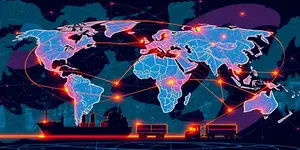
As the world economy shifts into a new phase, stakeholders must recognize how interconnected global markets operate and influence daily life. This article unpacks the forces at play, highlights major trends, and offers practical strategies for resilience.
After a burst of expansion following the pandemic, the global economy is expected to slow, with annual growth forecast at 2.9% in 2025 and 2.8% in 2026, down from 3.3% in 2024. Meanwhile, inflation is projected to ease to 2.1% in 2025 and 2.0% in 2026, though the U.S. remains an outlier.
These trends reflect a delicate balance between demand recovery and rising policy uncertainty. Higher trade barriers and evolving fiscal stances are major headwinds, signaling that businesses, investors, and governments must adapt to a slower but more complex environment.
Global markets are bound by multiple channels that facilitate the flow of goods, capital, people, and ideas. Understanding these conduits helps stakeholders anticipate risks and seize opportunities.
These mechanisms operate within a larger framework of public policy, legal systems, and consumer sentiment, creating a tapestry of forces that shape global growth patterns.
While integration has fueled prosperity, it also exposes economies to synchronized shocks. Recent U.S. tariffs have created a structural shock from tariffs that dampens global demand and raises the specter of recession if escalated.
Simultaneously, market fragmentation driven by geopolitical tensions is challenging the notion of seamless exchange. Protectionist measures, data localization rules, and divergent monetary policies are fragmenting markets into distinct blocs.
Businesses, policymakers, and individuals can navigate these challenges by embracing adaptive strategies that balance opportunity and risk. The following approaches foster durability and shared prosperity.
The North American Free Trade Agreement (NAFTA) exemplifies how regional integration can deepen commercial ties and spur growth. By eliminating tariffs and harmonizing standards, the U.S., Canada, and Mexico saw exponential increases in trade volume and cross-border investment.
Conversely, pandemic-driven supply disruptions highlighted the fragility of just-in-time models. Firms that preemptively diversified suppliers or reshored critical components fared better, underscoring the need for balance between cost efficiency and resilience.
As globalization evolves, stakeholders must ask: How can we leverage innovation and technology diffusion while safeguarding national interests? What role should states play in enforcing property rights and fostering inclusive policy frameworks?
The answers will shape whether the coming decade sees renewed cooperation or further fragmentation. By prioritizing adaptive policies and cross-border collaboration, the global community can steer toward sustainable growth.
Global markets are a tapestry of interconnected forces—trade, finance, labor, technology, and policy. While risks abound, they coexist with powerful opportunities for innovation, shared prosperity, and greater resilience.
By understanding the mechanisms at play and implementing public deficits and government spending responsibly, stakeholders can navigate uncertainty and build an inclusive future. The path forward demands collaboration, foresight, and a steadfast commitment to harnessing global interconnections for the benefit of all.
References













